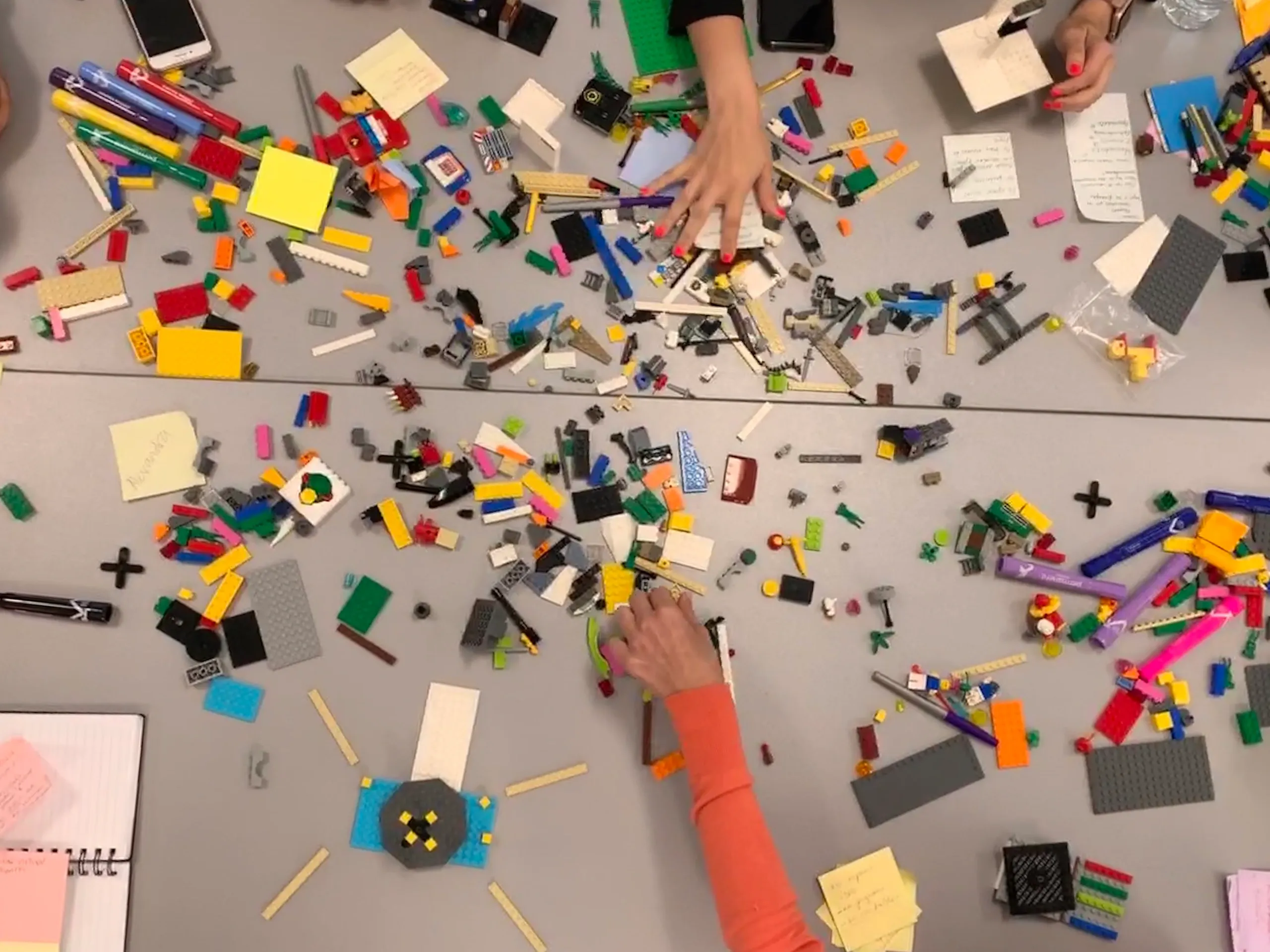
Market Disruptions: Are you DISRUPTING or will you be DISRUPTED?
It is 2020 and innovation has become crucial: innovate or die, they say. Most companies today realize the need to innovate in order to survive, but don’t know how to get started. Lateral Strategy breaks the process down into manageable chunks and helps you get out of innovation anxiety by guiding you through each step of the way. Whether you’re doing research to discover what needs to get done, ideating or validating a solution to get your idea to move forward, we know innovation is a struggle. We also know, that reluctance to innovate can crush a business, and we won’t let it crush yours.
So what can a company do to avoid being disrupted?
If you are a leader, then you understand how people feel about your product or service, right? Companies focus time and energy understanding the practical value of their products or service, but the symbolic value of the situation in which the product is bought, the stories, the complexities, and the quiet grievance behind why they buy is often left unattended. Companies have taken a mathematical approach to understanding consumers, and that can turn into liability.
At Lateral Strategy, we have noticed a massive disconnect between why people buy and why companies think people buy. When companies don’t understand what space their brand holds in the consumer’s life, they are missing out on a crucial aspect of insight hunting and innovation. Companies cannot continue being linear about innovation. They need to read between the lines to discover that, buried underneath what people do not say, is a treasure trove of opportunities.
The first step to innovate is therefore to understand consumers and the problem they would like to get solved. Articulating unmet needs is hard because ideas are fragile. That means, we wished the problem gets solved, but hardly know how it could be solved. The best way to approach innovation is through Human Centric Research, or the kind of research that allow client’s to understand consumer’s unspoken needs and values.
Research that is done through traditional methodologies may not yield the human insights needed to innovate. After years of taking a traditional approach to research and later becoming research user ourselves, we noticed how much potential there was to ask more meaningful questions and to make research more insightful through the use of different projective and creative dynamics. So Lateral Strategy took a different approach: we started doing research with the consumer in mind instead of the brand. That way people would reveal desires they might not even have known they had, and our brands were enabled to act upon them.
Because we are innovation developer’s, our research process is different. We start every project by asking clients what decision they want to make with the information gathered and what gaps of information they currently have. We call this the burning question– the questions they need answered before making a decision.
The biggest predictor of a client’s enthusiasm for innovation is the amount of interest they dedicate to discovering their burning research question. If they are looking for something quick and easy, or prefer to delegate the work completely, it is very likely that they are doing the research to cross it off their to do list or to confirm a preestablished hypothesis. In those situations, we recognize that we may not the right fit to lead the project, not because we don’t want to take on that type of work, but because Lateral Strategy focuses on actionable research and we know our talent will be underutilized. That is what we mean when we say we are looking for BOLD clients. Our best work is for BOLD people that are seeking BOLD opportunities to push INNOVATION forward.
Unfortunately, many clients still see research as a mere checkmark on their to-do list, something that needs to be done simply because that’s “just the way we were taught.” Shortcomings are rarely questioned, and flaws are seldom addressed. The marketplace has changed, and consumers have changed, but companies continue to rely on the traditional – an overly corporate business environment that makes seeking deeper understanding a challenge.
And that is why getting to the burning question is important. In the end it is really up to the client to decide whether they want a steak or a hot dog, and either choice is fine. The decision largely depends on what will be done with the information obtained- will they pursue innovation or add a checkmark to the “to-do” list?
At Lateral Strategy, we love innovation. We are committed to helping companies develop innovations through 2 services: Human Centric Research and Innovation Development. On our mission to recover the bold spirit traditional researchers have lost we avoid traditional methodologies to reveal what brands are really capable of. To this end, we are revolutionizing the way in which information is gathered and interpreted. Our goal is to inspire your team to find breakthrough solutions for the consumers they wish to serve.

Boldness has genius, power, and magic in it
Despite leaps in what we can do, most of us still follow comfortable, pre-scripted paths. We work hard, but hardly question whether we are working smart. Let alone, if we are leading a fulfilling life.
I have always admired authenticity and boldness. As a firm believer that everyone has some boldness within them, I’ve come to realize that it just takes someone to push the right buttons for this inner spark to come to life. In my training as a researcher and strategic planner, I was constantly pushed to question the status quo and to seek a further understanding of consumer behavior. Both clients looking for unique opportunities as well as agencies that embraced originality and big ideas pushed my buttons, inciting the audaciousness in me.
After 10 years immersed in the world of market research, I started to become bored of inauthentic conversations and an office culture that embraced being corporate – conventional, square, orthodox.
For some clients, research had become a way to highlight the good and cover up the bad. While others loved how I questioned shortcomings, addressed flaws, and pushed them to think of more creative ways to gather and interpret the information. If questioning assumptions and challenging conventional wisdom lead to innovation and growth, why were some clients so complacent about status quo?
So I decided to focus on clients seeking something new, different, braver, and bolder. Lateral Strategy was born out of the need to pursue an unconventional line of questioning to reach the deeper underlying issues plaguing a client’s entrepreneurial endeavors. Our mission became clear: to recover the bold spirit that researchers had lost sight of.
We are a new breed of Human Centric Research and Innovation Facilitation firm, that provides services to brands looking to better connect with consumers and make their products/services more meaningful and engaging. We dream of a world where companies connect with humans, not consumers. We believe that innovating on how we gather and interpret information inspires breakthrough solutions.
To this end, we go where others barely scratch the surface and ask what needs to be asked.
Using ingenious tools, we guide teams through various insight-led innovation processes that draw from Design Thinking, Creative Problem Solving, Lateral Thinking, and Synecticsframeworks to help clients rid themselves of innovation anxiety and get into the creative flow that allows them to view problems in a new light. With a newfound consumer perspective, we then inspire and help the client team to co-create solutions and detect bold business opportunities for their companies.
The world doesn’t need another market research agency, it needs more creative insights and more empowered employees inspired to problem solve. We need less of what has always been done, and more of what’s unexpected, refreshing, and bold.

Unstuck Blog (Part II)
Our last blog post focused on feeling “stuck” and offered a few ways to help you move forward. This week’s blog continues to explore the tools you can use to get “unstuck” and bring your ideas to life.
Below are two different approaches for getting your creative juices flowing, and real-life success stories that will inspire you to think laterally.
1. Reframe the problem
Retreat to the initial query and figure out a way to rework the question. By giving it a twist, you can trick your brain into thinking of it as a brand-new issue and in turn, that may help you come up with better ideas.
Here’s a clear example of what we mean. At the airport, people often complain about the long wait time at the baggage claim. Engineers asked themselves the obvious: “How can we speed up the conveyor belts?”. They invested thousands of dollars into the belt mechanisms and cut the wait time by more than half (15 minutes to 8 minutes).
Success, right? Well, people still complained.
The engineers then decided to rephrase the question to “How can we reduce passanger’s wait time?”. The new concept involved making the wait time shorter, not the baggage delivery faster. The solution: prolong the time it takes for passangers to arrive at the baggage claim area. At first, this may sound counterintuitive, but this solution not only increased customer satisfaction, but it also increased duty-free store sales.
The dilemma could have been posed in many different ways. Here is how other people have solved the problem:https://www.synectmedia.com/work-solution/reimagined-baggage-claim-experience It is important to note how the consumer pain point one chooses to solve for or the insight you chose to leverage, in this case Occupied time feels shorter than unoccupied time, has a direct impact on the type of solutions found.
What ideas can you come up with if the question had been “How to keep passengers entertained while waiting for their luggage”?
2. Assumption reversal
Imagine you’ve been hired to create a unique concept for a new restaurant. The most evident route to take is to think about modifying the food and/or the décor, both key elements of every restaurant. But, instead of adding something new, how about removing a variable from your restaurant?
Foremost, make a list of the things that every restaurant should have. Food, chairs, tables, cooks, waiters, an entry, etc. With such a long list of “should have”, there is little space to innovate!
Assumption reversal is a great tool for coming up with new concepts. It works like this: eliminate one item from the list and reimagine what a restaurant without that would look like. Say we choose to develop a restaurant without cooks! What ideas come to mind?
· Guests bring their own homemade meal, and the emphasis is put on excellent service.
· Guests choose from a variety of ingredients and cook communally.
· Students or children cook while learning core skills.
Say there were no tables…
· Guests could enjoy their food in a cozy lounge setting
· Guests eat standing at the kitchen table while the chef demonstrates how to prepare the dishes.
There exists a type of restaurant in some of the world’s most cosmopolitan cities (such as Paris, London, and NYC) that doesn’t have lights (http://travel.spotcoolstuff.com/unusual-restaurants-eating-in-the-dark). The idea is that by suppressing one sense the rest become heightened, leading you to relish your food that much more.
These are just some of the countless ideas you could come up with using this technique. We are so used to thinking that creativity lies in running free and uninhibited, that we overlook the fact that creativity can exist and flourish within restrictions.
Lateral Strategy specializes in moving ideas forward. We are an Insight and Innovation Studio that uses Creative Problem Solving, Design Thinking and Synectics Innovation Frameworks to help clients problem solve by understanding customer’s needs. Our services include Research, Ideation and Strategic Facilitation to help you learn the new, make sense of what you already know and pave the road to success. We bring actionable insight to all Research projects and move clients to solution finding faster.

Unstuck Blog (Part I)
Do questions such as, “Where am I?”, “How did I get here?” and “How can I move forward?” strike a particular nerve in you?
If the answer is yes, chances are, you’re stuck. So, what can you do to carry on?
It is entirely OK to be stuck. Being an expert on something can run us the risk of being blinded to other perspectives. While it can be hard to see the way out when you’re right in the thick of it, you must remember that we’ve all been stuck before, and have come out on the other side with great learnings (and stories) and relatively unharmed.
The good news is, you probably are not as stuck as you think, and there are a few things you can do to help yourself. Pause. Rethink. Find support. Remember, being stuck is fertile ground for a transformation to occur; it is an invitation to grow.
Beyond going out for a walk, detaching yourself from the problem, and ping-ponging ideas with a friend (the usual advice), here are three innovation tools/techniques that can help you get out of your creative block.
1. Seek out a different opinion
Odds are, many people and industries have had to confront challenges similar to the ones you are facing right now. Learn from them, observe how they solved the problem, and use that knowledge to your advantage. Often time the learnings are applicable to your problem or their approach could inspire your way of thinking.
When I worked in the restaurant industry, a bottleneck often formed in the cook line when certain dishes were ordered. The obvious solution would have been to eliminate those dishes from the menu, but instead, we commission a short experiment. To learn about this issue, we thought about other industries where speed and momentum were essential to problem-solving; two people studied the logistics of the pit stop at an auto race, while two others examined a speed dating session in New York City. We learned not only the importance that rehearsing and preparation can have but how the right flow (of people and ingredient placement) can avoid jamming the line. If most of the ingredients were readily prepared well beforehand, the sauté station wouldn’t get as congested in the middle of a busy shift.
This technique is derived from Lateral Thinking, the ability to use your imagination to see problems from a new, fresh angle in order to generate solutions. Lateral Strategy’s name is inspired by this strategic and creative thinking technique invented by Edward DeBono who became World famous for the six-thinking hats tool some of you have probably heard of.
2. Draw inspiration from hacks, workarounds and polarizing points of view.
Another suggestion is to seek extreme users, people who either overuse or underuse your product or service. Someone who has a completely different opinion on a certain issue than the average person can help you pull out meaningful needs that may not pop out when you focus on engaging with mainstream users. Extreme users have opposing attitudes and conversing with them can help you turn your conventional idea into a very unique one. You can find your niche in their uncommon interests, and perhaps even turn a rare concept into a trending topic.
One example of this is vegan food products. Not too long ago, dietary restriction was considered pretty extreme by the average consumer. Vegan products were perceived as unappetizing, bland, and pricey – until recently. Beyond Meat, a company that produces plant-based meat alternatives, partnered with Pizza Hut Puerto Rico to sell the “Beyond Sausage Pizza”. Vegans and meat-lovers alike are loving the newest menu item. The collaboration helped Beyond Meat move from niche to mainstream. Who would have guessed 10 years ago that a partnership like this one would have worked?
Lateral Strategy specializes in moving ideas forward. We are an Insight and Innovation Studio that uses Creative Problem Solving, Design Thinking and Synectics Innovation Frameworks to help clients problem-solve by understanding customers’ needs. Our services include Research, Ideation and Strategic Facilitation to help you learn the new, make sense of what you already know, and pave the road to success. We bring actionable insight to all Research projects and move clients to solution finding faster.

What is all the buzz behind Design Thinking?
According to the Interaction Design Foundation, Design Thinking (DT) is “an iterative process in which we seek to understand the user, challenge assumptions, and redefine problems in an attempt to identify alternative strategies and solutions…”All types of professionals and industry insiders can benefit from incorporating Design Thinking into their work, from artists and writers to engineers and scientists. It’s a mindset that positions the target user at the core, along with a solutions-based approach, in order to solve challenging problems.
According to Forrester Consulting, “Half of design-led companies surveyed by Adobe, say design thinking results in more satisfied and loyal customers; and 41 percent report greater market share as an advantage of having advanced design practices.” Link to source (https://landing.adobe.com/en/na/products/marketing-cloud/350450-forrester-design-led-business.html)
The term, Design Thinking, Human Centric Research and Design Research are confusing for many in the marketing industry, so we avoided using them for a long time. Suddenly, Design Thinking became a buzzword and garnered a lot of attention from the Fast Company, Harvard Business Review, among other prestigious institutions. Design Thinking began making appearances in employee training schedules and company rulebooks.
In simple terms, Design Thinking is a framework that allows people to do just that – think like a designer. Instead of pushing your design style on others and waiting for results, Design Thinking encourages you to focus on the end user (who you are designing for). The process has been so successful in Silicon Valley and the startup ecosystem, that people are now using it to create products and services; redefining how teams work, and how corporations’ function and interact.
If you are not a designer, you may be wondering what is so special about the way designers think. How is their thought process different than that of an engineer, or those taught at an MBA program?
Proper execution of Design Thinking drives better results and causes extraordinary things to happen within a company: human focus, collaboration, noteworthy ideas, experimentation, taking action, and innovation.
Design Thinking succeeds when it finds solutions based on the real needs of real people. In a recent Harvard Business Review article on the evolution of Design Thinking, Jon Kolko, a world-renowned design strategist, educator, and founder of the Austin Center for Design, said:
“When done well, human-centered design enhances the user experience at every touch point and fuels the creation of products and services that deeply resonate with customers. Design is empathic, and thus implicitly drives a more thoughtful, human approach to business.”
Today, many professionals identify as creative problem solvers or design thinkers. Consultancies are starting to sell Design Thinking facilitation and training workshops, and a growing number of companies are seeking training on Human Centric Design, Service Design, and Customer Experience to inspire Design Thinking within their organizations.
I have witnessed time and time again that companies approach Design Thinking with great intention. However, many limit themselves to training leaders, hoping that this alone will result in a more customer centric company. These companies perceive Design Thinking as the sole process that will compel their people to find an innovative solution to a customer problem and may be overlooking the importance of an innovative mindset.
I always stress that a design and creative mindset is not problem-focused, it’s solution-focused and action-oriented. It involves both analysis and imagination, data and insights. Yes, Design Thinking is a powerful and proven framework, and everyone wants to jump into the bandwagon. However, it must be accompanied by a robust innovation mentality, or else people will not be able to take full advantage of it.
One way to start investing in Design Thinking is to hire a professional facilitator like Lateral Strategy, whose expertise will ensure a seamless adoption of the process. A professional Innovation Facilitators we use multiple frameworks including Design Thinking, Lateral Thinking, Creative Problem Solving and Synnectics, and adapt them to our client’s needs and learning style. We can help identify some pitfalls in your team and innovation strategy. Then help you fill in those gaps, and introduce you to new skillsets that will take your company embrace a Design Thinking and Innovation mindset.
Knowing an innovation framework like #DesignThinking or #Agile is a great start, but might not be an advantage to begin innovating. Lateral Strategy can help your team get started on innovation by bridging this knowledge gap. Learn what human centricity means and how this approach can help your business attract more customers!

Part 3: How to Become a Better Innovator?
Part 1 of this series introduced the concept of innovating within a business and explained the benefits of establishing an innovation mindset within company culture. Part 2 was about understanding why is innovation so difficult for some organizations?
For another look at Part 1: Why Innovate? click here.
For Part 2: Why is innovating difficult for some organizations? click here.
For an innovation project to be successful companies must understand the following:
· Innovation is messy, ambiguous, and has many unknowns
· Innovation requires more insights than data to create the value that end consumers need
As discussed in Part 2 of this three-part series, bringing something to life is more complicated than keeping something up and running. By definition, innovation means bringing something new to life. Businesses must understand that the process of building something new is more complicated than that of keeping something running, and therefore the mindset is different. Innovating involves learning on the go. Because there is not enough data, people will be required to make assumptions, test them, and learn from the outcome, whatever that may be. It involves a complete reorientation of the way most companies operate.
Innovation is not crazy, it just requires a different way of thinking that is often overlooked by companies in the search for certainty. Companies must cultivate a culture where people feel comfortable dealing with the unknown because real life questions rarely have black and white answers. However, that doesn’t mean there is no direction. For example, when a CFO asks how much x is going to cost, an innovator may not be able to give an exact figure, but he or she will show the CFO how she would prioritize the budget to experiment and “go ahead” or “fail fast”- the concept of killing an idea fast so as not to consume additional resources.
Start nimble
Innovation is ambiguous, especially when trying to arrive at a life changing disruptive concept. It involves making decisions under a scenario of uncertainty where data might not be readily available for necessary future assumptions. Employees tend to feel safer within the expected (and controlled) environment most companies create. At one end of the spectrum, organizations love numbers. They quantify everything and measured results with KPI’s. At the other end, they expect people to seek growth by gaining new understanding and re-inventing the future. Doesn’t that sound illogical?
That is why the starting point to innovate should always be nurturing an environment for innovation to flourish in your workplace. Doing things differently requires a lot of elements, such as learning to take risks, and navigating uncertainty. Mitigating failure by starting small increases the organization’s confidence before rolling out a big innovation project. It is also essential to gain support from potential naysayers.
Once the organization is less burdened by status quo thinking, start with a simple project that will allow collaborators to explore and make decisions under a more ‘relaxed scenario’.
Innovation does not need to be a moonshot
Organizations (and employees) love big ideas for various reasons. Firstly, big ideas are perceived to drive greater results and if successful, have a larger impact on revenue. Secondly, most organizations incentivize competition over collaboration, which means that coming up with the bigger, more ambitious idea is perceived as more valuable. Thus, creating something truly innovative will feel much more rewarding than going for the low-hanging fruit.
Nevertheless, innovation can be a big idea that tweaks a low hanging fruit. Quick wins with minimal investment are a way to gain results and boost creative confidence before rolling out for the moonshot
Yet, it is important to know that quick wins are not the main drivers for innovation, and constantly chasing low-hanging fruits will not make you an innovator. It is a great starting point but innovation truly happens when people challenge assumptions and dream bigger. One of my favorite quotes puts it succinctly: “It’s easier to tame down a wild idea than it is to invigorate a weak one”.- Alex Osborne.
Innovation is fun and exciting. It employs a sense of discovery as people seek different perspectives to ideate solutions that solve concrete problems before finally reaching the new, unique idea.
Believe you can get there. You might not know how, but you can get there.

Part 2: Why is innovating so difficult for some organizations?
Part 1 of this series introduced the concept of innovating within a business and explained the benefits of establishing an innovation mindset within company culture. For another look at Part 1: Why Innovate? click here.
A study on innovation by McKinsey found that “only 6% of executives feel satisfied with their innovation performance.” It doesn’t take a math genius to see that means that 94% of executives are not fully happy with their performance regarding innovation. What makes the path to innovation so difficult?
From my perspective as Innovation Facilitator, these are the 3 most common mistakes I have observed when companies try to develop something new:
- Using operational skillset in the Innovation World
- Not engaging consumers
- Lacking a good environment for innovation to flourish
Using Operational Skillsets in the Innovation World
Take a moment to write down a list of skills that you need to be successful in the operational world, and another list of skills needed in the innovation world. You will immediately notice that the skills on both lists are so different that they sometimes contradict each other. This occurs because the operational world is where we execute our ideas, while in the innovation world we think about possibilities and create solutions. This is an extremely important concept to understand before embarking on an innovation project – what works in the operational world might not necessarily work when trying to innovate.
This important lesson comes from the Synectics Innovation Framework, one of the most complete Innovation Frameworks that I manage in Partnership with Synecticsworld Consultancy in Boston (link https://synecticsworld.com/). They found that in the operational/managerial world success is rational. Decisions are made based on data and stats, analyses are more rigorous, and jobs are usually somewhat repetitive. On the other hand, the world of innovation calls for curiosity, speculation, making connections, experimenting, and making adjustments on the fly. An operational skillset on its own should not be used to solve the problems encountered in the Innovation World.

Not Engaging Consumers
Many people innovate from their own perspective. That is, they will decide what they think the end user wants or what will sell the most according to their own attitudes, then innovate based on that. However, empathy and being able to see from an alternate perspective is essential for the innovation to be adopted by the end user. A sure way for innovation to fail is to develop a product or service nobody wants to buy!
A simple approach to innovate is to ask yourself, what is your customer accepting that should be unacceptable?
One of the biggest problems present in the business world today is a blind trust in quantitative information for decision-making at the expense of capturing insights. Many people rely too heavily on quantitative research to get to know their clients’ needs. While quantitative research is better than no research at all, when it comes to innovation qualitative research is essential. It brings the story behind the numbers to life, and these insights can be quantified. The importance of having insights is that insights give the creative brain a more dynamic and invigorating problem to solve. Insights are a key component of innovation, precisely because they inspire solutions.
If you truly want to innovate, engaging your consumer must be a deliberate part of your process.
Lacking an Innovation Environment
Shifting employee mindsets to embrace innovation is a first vital step. I cannot stress the importance of creating a culture of innovation within an organization enough. One cannot expect employees to embrace a new mindset and begin working on an innovation project at the same time. The moment the innovation project starts, employees need to already embody the innovation mindset.
An innovative organizational culture should start early and slow for it to prosper organically. This allows employees to adopt the mindset (empathy, creativity, curiosity, collaboration, courage, experimentation, long-term commitment, etc.) necessary to become innovative thinkers. Once people are aligned internally, innovation becomes a breeze. Well, maybe not a breeze, but certainly a solid starting point that will allow the team to end faster.
Now that you understand the reasons why innovating can be so challenging and you have been able to identify areas of improvement for your own business, Part 3 will give you a detailed guide towards becoming a better innovator.

Part 1: Innovation seems daunting
For the past few months, we have been navigating unprecedented times. By now, most of us would agree that uncertainty is scary, and the status quo feels much safer. I thought this might be the perfect time to talk about another intimidating subject – one that when not done correctly can also lead to tragedy – innovation.
To make this unique topic more digestible, this blog is organized into a three-part series:
Part 1 talks about the importance of Proactive (strategic) Innovation.
Part 2 explains why innovation might seem so daunting.
Part 3 will guide you through the steps you can take to become a better innovator.
Part 1 of 3: Why Innovate?
Any business that does not innovate runs the risk of falling behind and losing its competitive edge, subsequently losing its consumers and/or employees in the process. In an increasingly cutthroat and fast-paced environment, effectively adapting to change, being the first to navigate uncharted territory, and staying on top of the latest trends leads businesses to chase after innovation as if it were a race. It’s no wonder that economists estimate that 80% of business growth comes from innovation, and that innovation leads to 22% income growth.
While proactive businesses focus on anticipating trends and inventing the future, other businesses wait for the market to be disrupted, and then scramble to find a “me too” fixing. These businesses treat innovation reactively. The problem with this approach is that in order to respond to challenges, companies act under pressure and force innovation upon its employees (and purveyors). Innovation is not simply an end result or a one-stop effort taken to overcome an obstacle, and then abandoned in order to move on with business as usual. An innovation mindset should always be at the forefront of a business’s list of priorities.
Examples of reactive innovation techniques are waiting for customers complaints, sudden sales drops, or responding to a competitor’s most recent move. While there is nothing inherently wrong with these tactics, innovation should be strategic and less about last minute survival schemes.
Proactive innovators, on the other hand, are intentional about innovation. These are the companies that disrupt the market and build the future. Those that strategize to create niches are more customer centric and as a result, grow faster. It has been noted that proactive companies have a higher rate of success than reactive companies. Research demonstrates that the main difference between proactive and reactive companies often lies in the company’s culture. The Corporate Innovation Imperative Report revealed that fostering an internal culture of experimentation and innovation that adapts to change is the top challenge faced by 57% of respondents.
Proactive companies encourage innovation mindsets that nurture creative energy, curiosity, and collaboration among their employees. These mindsets have also been shown to boost employee morale and job satisfaction. Instilling these mindsets is crucial because the longer that employees stay in their comfort zone, the more stagnant they become and the more difficult it will become for a company to innovate. The status quo is further analyzed on Part 2 of this series. For now, just keep in mind that a stagnant organization will kill innovation.
One classic benchmark for culture of innovation is Google. Bill Gates’ tech giant has been credited for popularizing the concept of “20% time.” They not only allow, but actually encourage employees to spend 20% of their time to work on any project they believe they could add value to. And while not all organizations have the resources to install such programs, those that want to innovate must undoubtedly embed innovation into their organizational culture.
Of course, you might think your business endeavor is a far throw from Google, but don’t be discouraged. Although innovation can be difficult for some, any business (no matter how big or small) can use the right tools to take itself to the next level. Part 2 will explain why innovating is so difficult for some organizations. You will find it surprising that lack of resources is not the main barrier.

Research to push Innovation
I was recently on the client side watching focus groups moderated by a reputable research company. I was hired by the client as an Innovation Consultant to “grow the brand through product innovation”. This client contacted me after numerous unfruitful attempts to innovate and while I usually prefer getting involved earlier in the research process, I adapted. I have excellent relationships with my colleagues in the market research industry and I am always excited when Research is conducted prior to innovating. I passionately believe research guides better strategies, better ideas, and better solutions. However, research to move innovation forward is a tad different to regular market research.
While the focus groups where being conducted, I witnessed one of the clients moving uncomfortably. Forty-five minutes into the focus group, he left the client room and never came back. As he walked out, he voiced “I cannot keep listening to these appalling participants criticizing my brand” referring to some candid comments from participants who disliked the brand. The next day, he did not show up, which did not surprise any of us given that on that day we were going to talk to brand rejectors (clients who had tried our products and would not recommend it).
A week or so later, we gathered to get the research results and I noticed how the client’s biases dominated the room. Every time something “negative” came out, he would try justifying it “that is the perception of someone who had never used our brand”, “who said that?, it must have been a rejector”, or “that must have happened because of xyz”. So instead of paying attention, seek understanding and flipping threats into opportunities, this client was forcing the presenter to avoid deeper discussions of any negative comments that emerged during the research.
As the primary information user, I needed to understand the underlying meaning of how non-consumers and rejectors felt about the brand. This included, the good, the bad and especially the ugly. I wondered how I could use the information being obtained, if this person kept pushing the conversation towards the positive. As an Innovation Consultant, pain points create opportunities to innovate.
By the end of the presentation we were left with little information on how to “grow the brand through product innovation” but plenty of ideas to write this blog post.
I am narrowing the learnings down to the 3 things clients must be willing to do before deciding to conduct Market Research, especially if they want to innovate.
1. A client must be prepared to face the discomfort of consumers trashing their brand – Clients that turn a blind eye to negative feedback, hinder the effectiveness of any research initiative to innovate. Innovation is about fixing a consumer pain point, so it is extremely important that consumers talk about how your brand or product does NOT fit into their lives or might not fit their needs. If you are conducting research to give yourself a pat in the back and ignore any criticism, research won’t help you move your brand forward.
2. For research to be a good investment, clients must demand the market research agency to act as consultant, not just a provider of market information – Clients must be open and clear about what decisions will be made with the information gathered. Market research for innovation is very different to other types of market research. The research agency must understand this, because they will need to design the right methodology, ask the right questions and embrace new ways to gathering insights. Copy pasting old methodologies just won’t do it for product innovation!
3. Insights (the human problem, or the why, behind the business problem) not data is what leads to innovation – Getting to the insights requires a different kind of interaction with consumers. The tried and true focus group methodology might not be it. Don’t get me wrong, Focus Groups have a place in research but when you want to anticipate needs, you need specialized techniques. A moderator that asks respondents to rationalize why they do things will get superficial and often unsound answers in a group setting. People don’t know why they act the way they do, or even how to express what they want in the future.
To innovate, take the cliché and still highly relevant quote “If I had asked people what they wanted, they would have said faster horses” (H. Ford). A researcher should use tools to extract what the consumer future needs might look like — a faster mode of transportation. Customers might not have mentioned the need for faster transportation or a combustion engine, that is the art and science of anticipating needs.
If you want to discover, try something new; co-create with consumers, spend a few days with them, observe and ask question in the context of the consumer using the product and challenge consumer’s responses.
Reinventing the future is no small task. Hopefully, this article will inspire a few folks to question whether the traditional research formula will give them the understanding needed to spark the innovation your business might need to adapt and grow. As a research client and a research vendor, I incorporate creative problem solving and design thinking techniques to gather the insights that will lead to better innovation. Whether through research or innovation consulting, let us know how we can help you understand, create and innovate.

Are you solving the Right Problem?
WHY THE CLIENT NEEDED THE RESEARCH?
Sales for our client’s Insurance Plan had been declining for a while. Various initiatives, including increasing communication efforts and a considerable price drop had failed to move the needle. Lateral Strategy was hired to understand consumer’s perception of the plan and discover what could awaken interest in buying.
WHAT WAS DONE?
We set out to thoroughly understand Consumers perception and interest in the plan. It turned out Consumers loved the product features and found its price point very attractive. Many even had wished there was a protection plan for the product. When asked why they had declined the Plan, all were unaware that the company offered an insurance service. Moreover, there was real desire for the “insurance plan” as most consumers surveyed had spent more money fixing the product than the cost of the insuring it.
Had we solely been a Market Research firm, we would have given out client a report with the findings and walked away. But we felt that there was an inherent demand for this product in the market and we know market research is useless unless it provokes new thinking and new actions. We couldn’t just leave and make our client responsible for arriving at a solution by themselves.
We turned to the company’s sales database to understand what was going on and discovered the most recent hires were making the sales, whereas those working for over 2 years were hardly making any sales of the Insurance Plan. Digging deeper Lateral Strategy hit upon what was going on. It turned out that people working for the Company for a long time had discovered a loophole in the system and did not feel comfortable selling the Insurance Plan to their clients. They were more interested in developing a long term and trustworthy relationship with their clients, than in the incentive provided by the Company for selling the plan.
RESULTS
A new Plan was co-created with the sales people’s feedback, the loophole was closed, and sales went up 18%. Strikingly, the Insurance Plan had a price increase a year after the Research was conducted and sales remained intact.
